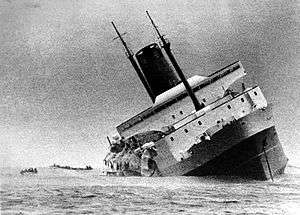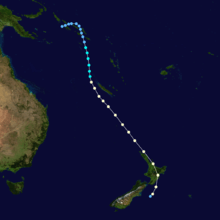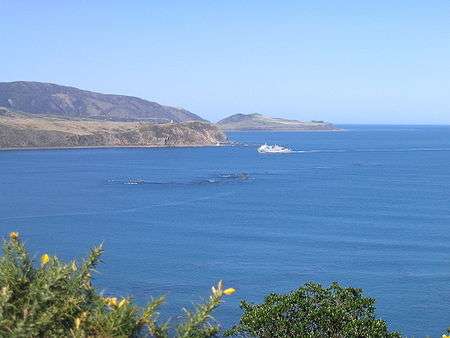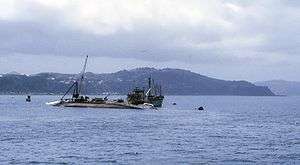TEV Wahine
 TEV Wahine lists heavily to starboard as she sinks in Wellington Harbour on 10 April 1968. Some of her lifeboats can be seen on the left. | |
| History | |
|---|---|
| Name: | TEV Wahine |
| Namesake: | Māori: woman |
| Owner: | Union Steam Ship Co of NZ[1] |
| Operator: | Union Steam Ship Co of NZ |
| Route: | Wellington – Lyttelton |
| Ordered: | October 1963[2] |
| Builder: | Fairfield Shipbuilding & Engineering,[2] Govan, Scotland |
| Yard number: | 830[1][2] |
| Laid down: | 14 September 1964[2] |
| Launched: | 14 July 1965[1][2] |
| Completed: | May 1966 |
| Maiden voyage: | 1 August 1966[2] |
| Out of service: | 10 April 1968 |
| Identification: | official number 317814 |
| Fate: | sunk in a cyclone |
| Status: | scrapped |
| General characteristics | |
| Type: | ferry[1] |
| Tonnage: | 8,948 GRT[1] |
| Length: | 488 ft (149 m)[1] |
| Beam: | 71 ft (22 m)[1] |
| Decks: | six[2] |
| Propulsion: | turbo-electric transmission;[1] twin screw plus stern and bow thrusters[2] |
| Capacity: | |
| Crew: | 126 |
TEV Wahine was a twin-screw, turbo-electric, roll-on/roll-off passenger and vehicle ferry of the Union Steamship Company of New Zealand. She was launched at the Fairfield Shipbuilding and Engineering Company in Govan, Scotland, in 1965 and worked the New Zealand inter-island route between Wellington and Lyttelton from 1966. On 10 April 1968, near the end of a typical northbound crossing to Wellington, she was caught in a fierce storm stirred by Tropical Cyclone Giselle. She foundered after running aground on Barrett Reef and capsized and sank in the shallow waters near Steeple Rock at the mouth of Wellington Harbour. Of the 734 people on board, 53 people died from drowning, exposure to the elements or from injuries sustained in the hurried evacuation and abandonment of the stricken vessel.[3]
The wreck of the Wahine is one of the better-known maritime disasters in New Zealand's history, although there have been worse, with far greater loss of life. Radio and television captured the drama as it happened, within a short distance of shore of the eastern suburbs of Wellington, and flew film overseas for world news.
Ship background
TEV Wahine was designed and built for the Union Steamship Company of New Zealand, and was one of many ferries that have linked New Zealand's North and South Islands. From 1875[4] ferries have plied Cook Strait and the Kaikoura coast ferrying passengers and cargo, making port at Wellington in the north and Lyttelton in the south. From 1933 the Union Company's Wellington – Lyttelton service was marketed as the "Steamer Express".[5]
By the early 1960s the Union Company was starting to face major competition. Apart from air travel, especially with the introduction of turboprop aircraft by the National Airways Corporation, in August 1962 New Zealand Railways began a roll-on/roll-off road and rail ferry across Cook Strait between Wellington and Picton, which continues as the Interislander. The Wahine was the Union Company's first purpose-built roll-on/roll-off ferry, introduced to maintain competition with the Railways ferries.
Building Wahine
Wahine was built by the Fairfield Shipbuilding and Engineering Company in Govan, Glasgow, Scotland. Plans were made by the Union Company in 1961, and her keel was laid on 14 September 1964 as Hull No. 830.[2] Built of steel, her hull was completed in 10 months, and she was christened and launched on 14 July 1965[1] by the Union Company's director's wife. Her machinery, cargo spaces and passenger accommodations were installed in the following months and she was completed in May 1966. She left Greenock, Scotland for New Zealand on 18 June 1966 and arrived in Wellington on 24 July 1966; she sailed on her maiden voyage to Lyttelton one week later, on 1 August.[2]
She was 488 feet (149 m) long,[2] had a beam of 71 ft (22 m)[1] and 8,948 gross register tons (GRT).[1] At the time she was the Union Company's largest ship and one of the world's largest passenger ferries.[2] She had turbo-electric transmission, with four boilers supplying steam to two turbo-alternators that drove her twin main propellers, gave a top speed of 22 knots (41 km/h). She had stern and bow thruster propellers to propel her sideways for easier berthing.[2] She had stabilisers that halved the amount she rolled and the frequency with which she did so.[2]
Her hull was divided by 13 watertight bulkheads into 14 watertight compartments, designed so that if the hull was penetrated flooding could be confined to the damaged area. As with all passenger ships built since the Titanic disaster, she had enough lifeboats and life rafts for all passengers and crew: eight large fibreglass lifeboats, two 26-foot motor lifeboats each with a capacity of 50 people, six 31-foot standard lifeboats each with a capacity of 99 people, and 36 inflatable rafts, each with a capacity of 25 people.
Service
Wahine entered service on 1 August 1966 with her first sailing from Wellington.[2] Between then and the end of the year she made 67 crossings to Lyttelton.[2]
On a normal crossing she had a crew of 126: in the deck department, the master, three officers, one radio operator and 19 sailors managed the overall operation; in the engine department, eight engineers, two electricians, one donkeyman and 12 general workers supervised the operation of the engines; in the victualing department, 60 stewards, seven stewardesses, five cooks and four pursers catered to the needs of the passengers.
On trips made during the day she could carry 1,050 passengers, on overnight crossings 927,[2] in over 300 single-, two-, three- and four-berth cabins, with two dormitory-style cabins each sleeping 12 passengers. Common areas included a cafeteria, lounge, smoke room, gift shop, two enclosed promenades and open decks. She had two vehicle decks with a combined capacity for more than 200 cars.[2]
Final crossing
On the evening of 9 April 1968 she departed from Lyttelton for a routine overnight crossing, carrying 610 passengers and 123 crew.
Extreme weather conditions

In the early morning of 10 April two violent storms merged over Wellington, creating a single extratropical cyclone that was the worst recorded in New Zealand's history. Cyclone Giselle was heading south after causing much damage in the north of the North Island. It hit Wellington at the same time as another storm that had driven up the West Coast of the South Island from Antarctica.[6] The winds in Wellington were the strongest ever recorded. At one point they reached 275 kilometres per hour (171 mph) and in one Wellington suburb alone ripped off the roofs of 98 houses. Three ambulances and a truck were blown onto their sides when they tried to go into the area to rescue injured people.
As the storms hit Wellington Harbour, Wahine was making her way out of Cook Strait on the last leg of her journey. Although there were weather warnings when she set out from Lyttelton, there was no indication that storms would be severe or any worse than those often experienced by vessels crossing the Cook Strait.[6]
Aground in Wellington Harbour
At 0550 hrs, with winds gusting at between 100 kilometres per hour (62 mph) and 155 kilometres per hour (96 mph),[2] Captain Hector Gordon Robertson decided to enter harbour. Twenty minutes later the winds had increased to 160 kilometres per hour (99 mph), and she lost her radar. A huge wave pushed her off course and in line with Barrett Reef. Robertson was unable to turn her back on course, and decided to keep turning around and back out to sea.
For 30 minutes she battled into the waves and wind, but by 0610 hrs she was not answering her helm[2] and had lost control of her engines. At 0640 hrs she was driven onto the southern tip of Barrett Reef,[2] near the harbour entrance less than a mile from shore. She drifted along the reef, shearing off her starboard propeller and gouging a large hole in her hull on the starboard side of the stern, beneath the waterline. Passengers were told that she was aground but there was no immediate danger.[2] They were directed to don their lifejackets and report to their muster stations.[2] as a routine "precautionary measure".
The storm continued to grow more intense. The wind increased to over 250 kilometres per hour (160 mph) and she dragged her anchors and drifted into the harbour. At about 1100 hrs, close to the western shore at Seatoun, her anchors finally held.[2] At about the same time the tug Tapuhi reached her and tried to attach a line and bring her in tow, but after 10 minutes the line broke.[2] Other attempts failed, but the deputy harbourmaster, Captain Galloway, managed to climb aboard from the pilot boat.[2]
Throughout the morning, the danger of the ship sinking seemed to pass as the vessel's location was in an area where the water depth did not exceed 10 meters (30 ft), and the crew's worst-case scenario was the clean-up once the vessel either arrived in Wellington or had grounded in shallower water. There was indication that the ship would even sail again that evening as usual, albeit later than scheduled while the damage done by the reef was repaired.
Disaster unfolding

At about 1315 hrs the combined effect of the tide and the storm swung Wahine around, providing a patch of clear water sheltered from the wind. As she suddenly listed further and reached the point of no return, Robertson gave the order to abandon ship.[2] In an instance similar to what had occurred during the sinking of the Italian passenger liner Andrea Doria off the coast of New England in 1956, the severe starboard list left the four lifeboats on the port side useless: only the four on the starboard side could be launched.
The first starboard motor lifeboat, boat S1, capsized shortly after being launched.[2] Those aboard were thrown into the water, and many were drowned in the rough sea, including two children and several elderly passengers.[2] Survivor Shirley Hick, remembered for losing two of her three children in the disaster, recalled this event vividly, as her three-year-old daughter Alma had drowned in this lifeboat. Some managed to hold onto the overturned boat as it drifted across the harbour to the eastern shore, towards Eastbourne.
The three remaining standard lifeboats, which according to a number of survivors were severely overcrowded, did manage to reach shore. Lifeboat S2 reached Seatoun beach on the western side of the channel with about 70 passengers and crew, as did Lifeboat S4, which was severely overcrowded with over 100 people. Heavily overcrowded Lifeboat S3 landed on the beach near Eastbourne, about 3 miles (5 km) away on the opposite side of the channel.[7]
Wahine launched her life rafts, but waves up to 6 metres (20 ft) high capsized some of them and many people were killed.[2] She sank in 38 feet (12 m) of water.[2] forcing hundreds of passengers and crew into the rough sea. When the weather cleared, the sight of her foundering in the harbour urged many vessels to race to the scene, including the ferry GMV Aramoana,[2] tugs, fishing boats, yachts and small personal craft. They rescued hundreds of people. Over 200 passengers and crew reached the rocky shore of the east side of the channel, south of Eastbourne. Because this area was desolate and unpopulated, many survivors were exposed to the elements for several hours while rescue teams tried to navigate the gravel road down the shoreline. It was here that a number of bodies were recovered.[7]
At about 1430 hrs Wahine rolled completely on her starboard side.[2]
Some of the survivors reached the shore only to die of exhaustion or exposure.[2] Fifty-one people died at the time, and two more died later from their injuries, 53 victims in all. Most of the victims were middle-aged or elderly, but included three children; they died from drowning, exposure or injuries from being battered on the rocks. Forty-six bodies were found; 566 passengers were safe, as were 110 crew, and six were missing.
Aftermath
Investigation

Ten weeks after the disaster, a Court of Inquiry found errors of judgement had been made, but stressed that the conditions at the time had been difficult and dangerous. The free surface effect caused Wahine to capsize due to a build-up of water on the vehicle deck,[2] although several specialist advisers to the inquiry believed that she had grounded a second time, taking on more water below decks.
The report of the inquiry stated that more lives would almost certainly have been lost if the order to abandon ship had been given earlier or later. The storm was so strong that rescue craft would not have been able to help passengers any earlier than about midday. Charges were brought against her officers but all were acquitted.
Early hopes that she could be salvaged were abandoned when the magnitude of structural damage became clear. As the wreck was a navigational hazard, preparations were made over the next year to refloat her and tow her into Cook Strait for scuttling. However a similar storm in 1969 broke up the wreck, and it was dismantled (partly by the Hikitia floating crane) where it lay.
Memorials
Wahine Memorial Park marks the disaster with a bow thruster, near where the survivors reached the shore at Seatoun. J G Churchill Park in Seatoun has a memorial plaque, the ship's anchor and chain (one link per victim), and replica ventilators. A plaque and the main mast are at the parking area next to Burdans Gate on the eastern side of the harbour, on the coast where many of the survivors and dead washed up. The fore-mast is part of another memorial in Frank Kitts Park in central Wellington. The Museum of Wellington City & Sea has a permanent commemorative exhibition on its maritime floor that includes artifacts and a film about the storm and the sinking.
In 2013, Ngaire Lilly ( née Bowen ), a survivor of the Wahine, wrote her own book about the event.
Replacement ship
It was more than a year before the Union Company ordered a ferry to replace Wahine. In May 1969 it ordered TEV Rangatira, built by a different British shipyard and to a new design.[8] She had accommodation for 159 fewer passengers, and like Wahine could carry more than 200 cars.[5][8]
Rangatira did not enter service until March 1972,[5][8] almost four years after Wahine was wrecked. She was a commercial failure, carrying on average only just over half the number of passengers and a third of the vehicles for which she had capacity.[5][8] From 1974 the NZ Ministry of Transport subsidised the "Steamer Express", but in 1976 it withdrew the subsidy and the service ceased.[5][8]
References
- 1 2 3 4 5 6 7 8 9 10 11 Cameron, Stuart; Strathdee, Paul; Biddulph, Bruce; Campbell, Colin (2002–2013). "Wahine". Clydebuilt database. Clydesite.co.uk. Retrieved 2 May 2013.
- 1 2 3 4 5 6 7 8 9 10 11 12 13 14 15 16 17 18 19 20 21 22 23 24 25 26 27 28 29 30 31 32 33 34 35 36 37 Castell, Marcus (2003–2007). "The Turbo Electric Vessel WAHINE, 1966–1968". The New Zealand Maritime Record. Retrieved 22 May 2013.
- ↑ Initially the official toll was 51, but two names were added 22 and 40 years later.Williamson, Kerry (9 April 2008). "Recognition 53rd Wahine victim". The Dominion Post. Retrieved 10 April 2008.
- ↑ "History of Cook Strait ferries". KiwiRail. 2011. Retrieved 11 May 2012.
- 1 2 3 4 5 "Steamer Express". New Zealand Coastal Shipping. 2003–2009. Retrieved 29 May 2013.
- 1 2 "Wahine Shipwreck". New Zealand Disasters. Christchurch City Libraries. Retrieved 7 June 2008.
- 1 2 "Questions and Answers". The Wahine. Retrieved 31 July 2011.(subscription required)
- 1 2 3 4 5 Castell, Marcus (2003–2005). "The Turbo Electric Vessel Rangatira of 1971". The New Zealand Maritime Record. Retrieved 29 May 2013.
Further reading
- Boon, Kevin (1999) [1990]. The Wahine Disaster. Petone: Nelson Price Milburn. ISBN 0-7055-1478-1. — a booklet for children
- Ingram, C.W.N. (1980) [1936]. New Zealand shipwrecks: 195 years of disaster at sea. Auckland: Beckett. ISBN 0-908676-49-2. The 1980 edition includes a chronological hour-by-hour account of the Wahine's sinking and details of the ensuing Court of Inquiry.
- Lambert, Max; Hartley, Jim (1974) [1969]. The Wahine Disaster. Auckland; [ Wellington ]: Collins Fontana Silver Fern; [ AH & HW Reed ]. ISBN 0589003771.
- Makarios, Emmanuel (2003). The Wahine Disaster: a tragedy remembered. Wellington: Grantham House. ISBN 1-86934-079-5.
- Revell, Michael J; Gorman, Richard M (2003). "The Wahine storm" (pdf). New Zealand Journal of Marine and Freshwater Research. Taylor & Francis Online. 37 (2): 251–266. doi:10.1080/00288330.2003.9517163. – an academic evaluation of the meteorology of Hurricane Giselle.
- T.E.V Wahine (O.N. 317814) Shipping casualty 10 April 1968 Report of Court and Annex Thereto. November 1968. — the official report of the Court of Inquiry.
External links
- Boon, Kevin. "The Wahine Disaster". New Zealand. – gives an account of the sinking, with links to Cyclone Giselle and other New Zealand disasters.
- Castell, Marcus (2003–2007). "The Turbo Electric Vessel WAHINE, 1966–1968". The New Zealand Maritime Record. – a detailed account of the ship, including the sinking, with many photographs.
- Lambert, Max (1970). The Wahine Disaster. New Zealand Electronic Text Collection. Victoria University of Wellington.
- Robinson, Murray (2006). "The Wahine and Captain Robertson". – comprehensive site detailing the ship's last hours, her history of operation and her Captain's career.
- "The Wahine disaster". New Zealand History online. New Zealand Ministry for Culture and Heritage. – includes images, sound and video
- "Co-ordinating the rescue – Wahine Disaster". New Zealand History online. New Zealand Ministry for Culture and Heritage. – explores the ability of the police to respond to the Wahine disaster.
- "1968: Dozens die in NZ ferry disaster". On This Day 1950 – 2005, 10 April. BBC.
- "Deaths from the sinking of the T.E.V. Wahine". Welcome To Sooty's Home Page. Ancestry.com. – lists those who died in the disaster.
- "The Wahine Disaster Trailer" (video). Boro TV Limited. 2008.
- "DomPostPics". The Dominion Post. – photos of Wahine: enter, go to Categories:Archive;Wahine
- "The day the Wahine went down". Wairarapa Times-Age. Archived from the original on 8 January 2005.
- "(DVD of television documentary)". Television New Zealand. Archived from the original on 18 May 2011.
Coordinates: 41°20′50″S 174°50′20″E / 41.34722°S 174.83889°E